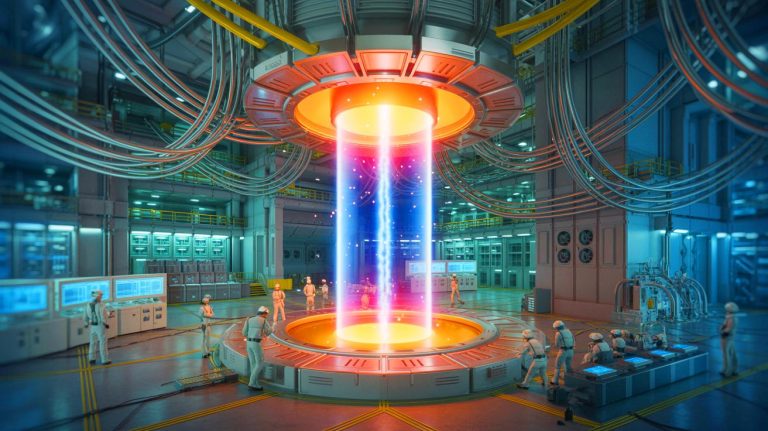| IN A NUTSHELL |
|
The international scientific community has made a significant advancement in the quest for sustainable energy. Recently, the ITER project achieved a monumental milestone by completing the sixth and final component of the reactor’s central solenoid. This magnet, powerful enough to levitate an aircraft carrier, holds the potential to revolutionize energy production and space exploration. Beyond its technological triumph, this achievement underscores the strength of international collaboration in tackling global challenges.
Understanding the Role of the Central Solenoid
The central solenoid is a vital component of the ITER Tokamak reactor, functioning as the driving force behind the fusion process. This superconducting magnet is essential for creating and sustaining the superheated plasma required for nuclear fusion. Inside the reactor, the plasma core, composed of ionized hydrogen gas, reaches temperatures of 270 million degrees Fahrenheit, which is ten times hotter than the sun’s core. Such extreme heat facilitates the fusion of atomic nuclei, releasing substantial energy in a fusion reaction.
The solenoid, once fully assembled, will weigh nearly 6.6 million pounds, towering at 42.6 feet tall and 13.1 feet wide. It operates alongside other magnetic systems to construct a magnetic cage, confining the plasma and enabling engineers to control the fusion reaction. At maximum performance, the solenoid withstands forces equivalent to 13.5 million pounds, illustrating the engineering marvel that enables this fusion breakthrough.
The Significance of a Magnet That Can Levitate an Aircraft Carrier
The significance of this magnet becomes clear when considering the extreme conditions necessary for nuclear fusion. The reactor’s temperatures are so intense that no material container could endure them, necessitating the use of magnetic fields to suspend the plasma in mid-air, thus preventing physical contact with the reactor walls. The central solenoid is crucial in this process, providing the magnetic force required to suspend the plasma for durations of 300-500 seconds.
While the ability to levitate an aircraft carrier is a measure of power, it is also a necessity for achieving the desired fusion reaction. The solenoid’s magnetic energy storage, amounting to 6.4 gigajoules, attests to its capacity. With this technology, ITER aims to produce 500 megawatts of power with just a 50-megawatt input, highlighting the potential for a future rich in clean, abundant energy.
International Collaboration and Its Impact
The ITER project exemplifies the power of international cooperation. With Europe shouldering 45% of the costs and six other countries contributing 9% each, ITER represents a global endeavor to address energy demands. The project’s success underscores how nations can transcend differences to tackle existential challenges such as climate change and energy security.
Pietro Barabaschi, ITER’s Director-General, points out that the project’s technical complexity and international framework are crucial to its success. Despite varying political landscapes, this collaboration has remained steadfast, proving that humanity can unite for a greater cause. As the project progresses, the world watches in anticipation of the transformative potential that nuclear fusion holds for the future.
Challenges Ahead and the Road to Completion
Despite its accomplishments, ITER faces challenges on the path to becoming fully operational. Having commenced in 2007, the team now projects the first operation by 2035. This timeline reflects the project’s intricate nature, demanding precise engineering and coordination among international partners.
As reactor assembly continues, the challenges of integrating complex systems and ensuring safety standards persist. However, the advancements achieved thus far inspire optimism that the ultimate goal is within reach. The successful operation of ITER could herald a new era in energy production, impacting industries and societies globally.
The completion of the central solenoid signifies a crucial milestone in the journey toward harnessing fusion energy. As the ITER project advances, it embodies the power of human ingenuity and cooperation. Could this fusion breakthrough pave the way for a sustainable energy future, transforming how we power our lives and explore the cosmos?







Wow, a magnet that can lift a warship! Can it help me find my keys too? 😂
Impressive technology, but is it economically viable in the long run?
This is mind-blowing! Can’t wait to see what happens next. 🚀
Sounds like science fiction becoming reality! Amazing!
How do they ensure the safety of such a powerful magnet?
I hope this leads to cleaner energy solutions worldwide. 🙏
The international collaboration here is truly inspiring! 🌍
Levitate an aircraft carrier? That sounds like a Marvel movie plot! 😲
Could this technology be applied in other fields beyond energy production?
2035 seems so far away! Why does it take so long?
Is this project receiving enough funding to ensure its success?
Big thanks to the team making this possible! You’re changing the world!
What’s the next step after building this magnet?
How do they plan to address the remaining challenges?
Can we expect to see commercial fusion reactors in our lifetime?
What are the geopolitical implications of this energy breakthrough?
I’m skeptical. We’ve heard promises about fusion energy for decades. 🤔
Does this mean cheaper electricity bills in the future? 💡
How does this compare to other fusion projects around the world?
Can the magnet’s technology be miniaturized for other applications?
Are there any risks associated with operating such a powerful magnet?
I’m so excited about the potential of fusion energy! Go ITER! 🎉
Is ITER planning any public demonstrations of this technology?
What are the potential downsides of this kind of energy production?
How does this compare to renewable energy sources like solar and wind?
Thank you to all the scientists working tirelessly on this project! 🌟
What are the main technical challenges still to be overcome?
Can this technology help combat climate change effectively? 🌎
I’m curious about the technical details—where can I learn more?
Could this lead to a new era in space exploration? 🌌
Can someone explain how this magnet actually works? I’m lost!
How does this development impact the timeline for achieving fusion energy?
Is the environmental impact of building such a massive magnet considered?